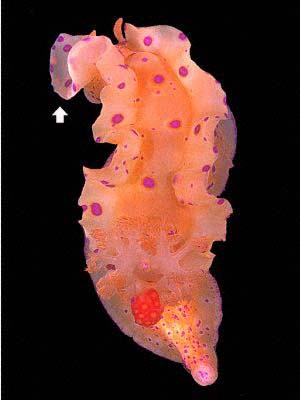
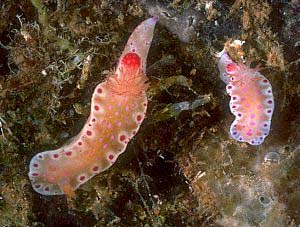
Ceratosoma brevicaudatum
Abraham, 1876
Order: NUDIBRANCHIA
Suborder: DORIDINA
Family: Chromodorididae
DISTRIBUTION
Southern Australia from about Perth in the west to northern New South Wales in the east.
PHOTO
UPPER: Adult showing bright red patterned dorsal 'tail' which contains most of the defensive glands. A few small mantle glands (white arrow) remain at the mantle edge on the side of the head. Solitary Islands, Coffs Harbour, northern New South Wales, Australia, May 1982.
LOWER: Juveniles on sponge showing the prominent red colour drawing attention to the most distasteful part of the animal's body. Tumby Bay, Eyre Peninsula, Sout Australia, February 1985.
PHOTOS: Bill Rudman.
RELATED TOPIC
Defensive colouration in sea slugs
Most species of Ceratosoma have a long recurved dorsal 'horn' which acts as a defensive lure attracting potential predators to the part of the animal which contains most of the distasteful chemicals stored from their food. Although this species, as its name suggests, has a very short 'tail' it is conspicuously marked, especially in juveniles. This colour 'target' probably also attracts potential predators to the most distasteful part of the animal.
Reference:
• Abraham, P.S. (1876). Notes on some genera of nudibranchiate mollusca, with notices of a new genus and some hitherto undescribed species in the collection of the British Museum. Annals and Magazine of Natural History, 18(4): 132-146
Rudman, W.B., 1998 (October 14) Ceratosoma brevicaudatum Abraham, 1876. [In] Sea Slug Forum. Australian Museum, Sydney. Available from http://www.seaslugforum.net/find/cerabrev
Related messages
Ceratosoma brevicaudatum from Melbourne, Australia
April 6, 2010
From: James Bailey
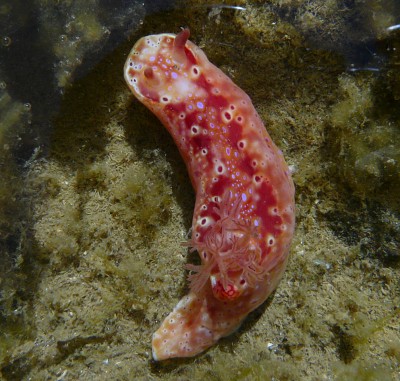
I have attached a photo of a common Sea Slug that I find in the rock pools at Brighton Beach in Melbourne, Australia. Sea slugs fascinate me, and I feel somewhat disappointed I can't put a name to this one. Thanks in advance.
Locality: Brighton Beach, Brighton, Melbourne, Australia, in shallow rock pool, Victoria, Port Phillip Bay, 05 April 2010, Rock pools. Length: No length available.. Photographer: Myself.
James Bailey
silverwolf.lupinewilderness@hotmail.com
Bailey, J.P., 2010 (Apr 6) Ceratosoma brevicaudatum from Melbourne, Australia. [Message in] Sea Slug Forum. Australian Museum, Sydney. Available from http://www.seaslugforum.net/find/23446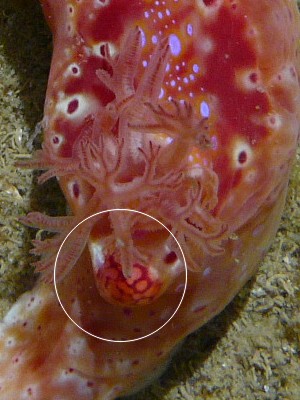
Dear James,
This is Ceratosoma brevicaudatum. Most species of Ceratosoma are found in the warm tropical waters of the Indo-West Pacific and as you will see with Ceratosoma trilobatum they usually have a long recurved dorsal 'horn' which sticks up from the body behind the gills. This horn has an interesting defensive function because it is where the animal stores distasteful and noxious chemicals its has removed from its sponge food. The horn appears to act as a sacrificial lure, tempting fish to take a bite. When or if they do they get a mouth full of nasty chemicals which teach them to leave Ceratosoma alone. As the 'hom' has no other function, the slug can live quite happily without it.
It seems that Ceratosoma brevicaudatum represents an early stage in the evolution of the dorsal horn. In the close-up alongside I have ringed the swollen 'bump' which is found in this species. It is packed full of noxious chemicals and is usually more brightly coloured thyan the rest of the body - again acting as a lure. If you look at some of the other messages on thsi species, which are attached to the Fact Sheet, you will see that in juveniles the horn is even more brightly coloured.
The name brevicaudatum means 'short tail' in Latin, which is a reference to this very short dorsal horn.
Best wishes,
Bill Rudman
Ceratosoma brevicaudatum laying eggs
April 10, 2007
From: Leanne & David Atkinson
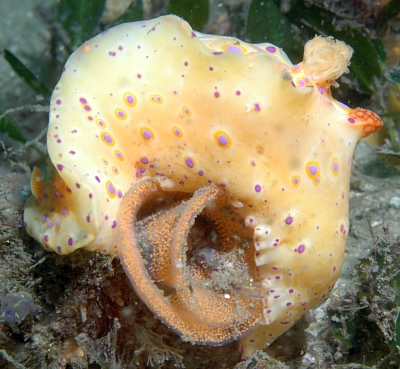
Dear Bill,
Our dive buddy Greg Convery spotted this Ceratosoma brevicaudatum laying eggs. We know we've already sent you one of it laying eggs but thought this one was up higher and we were able to get better photos of it.
Locality: Fly Point Marine Reserve, Port Stephens, 8 metres, New South Wales, Australia, Pacific, 10 March 2007, Sandy bottom scattered sponges, seagrasses, soft corals, ascidians and bryozoans. Length: Approximately 80 mm. Photographer: Leanne & David Atkinson.
Hope they are of use.
Regards,
Leanne & David Atkinson
atk@hunterlink.net.au
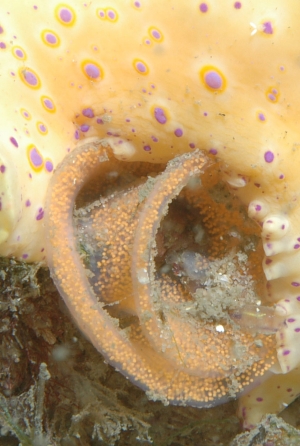
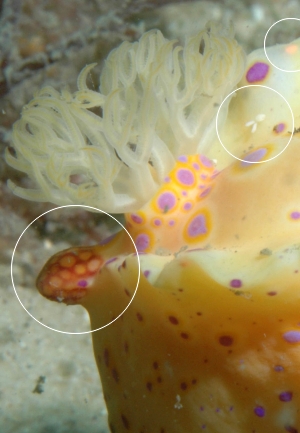
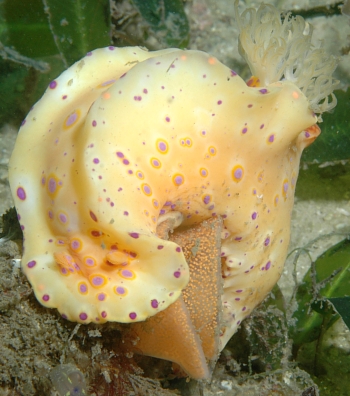
Dear Leanne & David,
Thanks for these nice photos. I couldn't resist including a close-up showing three interesting features [middle right photo]. In the upper ring is one of the orange mantle glands which contains distasteful chemicals from the sponges it feeds on. In the middle ring is a commensal copepod crustacean with 2 egg sacs, and the bottom ring shows the short 'tail' which gives this species its name [brevi = short; caudatum = tail]. This swollen 'tail' stores most of the antifeedant chemicals and because it is a contrast in colour to the rest of the animal, I have hypothesised that it acts as a lure, attracting fish to taste the most distasteful and unnneeded part of the body.
Best wishes,
Bill Rudman
Ceratosoma brevicaudatum from Western Australia
January 30, 2007
From: Bruce Potter
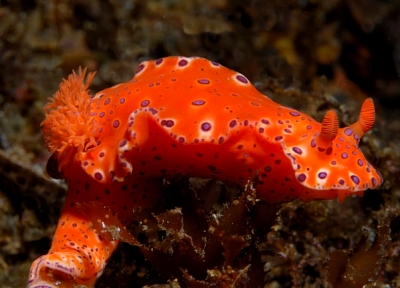
Dear Bill,
Over the past couple of years I saw plenty of Ceratosoma brevicaudatum in Nelson Bay, New South Wales. They were usually quite large and pale in colour. I have now moved over to Western Australia and over the year end I dived under the Busselton jetty, where I saw lots of C. brevicaudatum but they were smaller and much more colourful than the ones I saw on the east coast.
Locality: Busselton, 8 metres, Western Australia, Indian Ocean, 6 January 2007, under a jetty. Length: 55 mm. Photographer: Bruce Potter.
This one was about 55 mm long.
Regards
Bruce Potter.
bandppotter@bigpond.com
Potter, B., 2007 (Jan 30) Ceratosoma brevicaudatum from Western Australia. [Message in] Sea Slug Forum. Australian Museum, Sydney. Available from http://www.seaslugforum.net/find/19241Dear Bruce,
For some reason, C. brevicaudatum in New South Wales is always quite pale, although there is quite a range in color. Certainly in South Australia and apparently right around the southern coast of Asutralia to southern Western Australia the colours become much more intense. I have no idea why.
Best wishes,
Bill Rudman
Ceratosoma brevicaudatum from Port Philip Bay
March 25, 2006
From: Bill van Eijk

I have used the images on your website to ID the slug as Ceratosoma brevicaudatum. You may wish to double check, however. I saw 2 specimens one at about 4 metres deep and one closer to the coast at about 2 metres.
Locality: Ricketts Point, 2 - 4 metres, Vic, Australia, Port Phillip Bay, 12/03/06, Marine reserve, rocky. Length: 8 cm. Photographer: Bill van Eijk.
Bill van Eijk
vaneyk@vegas.com.au
van Eijk, W., 2006 (Mar 25) Ceratosoma brevicaudatum from Port Philip Bay. [Message in] Sea Slug Forum. Australian Museum, Sydney. Available from http://www.seaslugforum.net/find/16108
Dear Bill,
Yes this is C. brevicaudatum. As I have mentioned before, the name means 'short tail' which is very obvious in your photo. Compare it with the long recurved dorsal 'horns' in C. trilobatum.
Best wishes,
Bill Rudman
Ceratosoma brevicaudatum mating
January 21, 2006
From: Leanne & David Atkinson
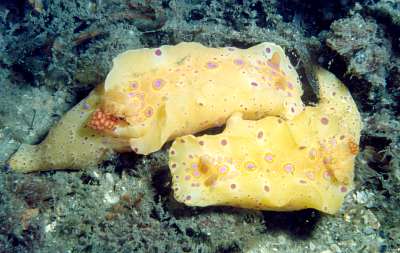
Dear Bill,
There have been a lot of nudibranchs mating and laying eggs in the Port Stephens area in December and January. We found Ceratosoma brevicaudatum mating and there didn't seem to be any photos of this behaviour on the forum so though we would send this one in.
Locality: Fly Point Marine Reserve, Port Stephens, NSW, Australia. Depth: 12 metres. Length: 120 mm. 07 January 2006. Sandy bottom with scattered sponges, ascidians and soft corals. Photographer: Leanne & David Atkinson
Regards,
Leanne & David Atkinson
atk@hunterlink.net.au
Atkinson. L. & D., 2006 (Jan 21) Ceratosoma brevicaudatum mating. [Message in] Sea Slug Forum. Australian Museum, Sydney. Available from http://www.seaslugforum.net/find/15603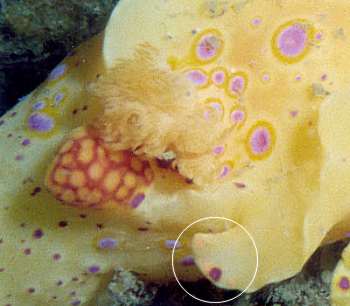
Thanks Leanne & David,
I've included a close-up of the gill area of one of your animals, not because it has anything to do with mating but it shows the 'short tail' [brevi = short; caudatum = tail] which gave this species its name. Compare the rounded bump - with the red network pattern - with the massive curved dorsal process of Ceratosoma trilobatum. The red pattern is also interesting because the stumpy tail is where this species stores most of the distasteful chemicals it gets from its sponge food. My theory is that the red pattern is a lure to attract fish to the most distasteful part of the slug and so make the whole slug unattractive to hungry fish. I have ringed a section of the mantle edge which has a few extra - three in fact - small orange mantle glands.
Best wishes,
Bill Rudman
Juvenile Ceratosoma brevicaudatum from W. Australia
October 25, 2005
From: Chris Cunnold
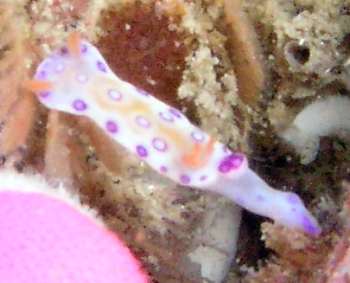
Dear Bill,
Ceratosoma brevicaudatum is very common in waters around Perth, Western Australia, however I've only once seen one this small (I would estimate around 6-8mm).
Locality: Fremantle, Western Australia, Indian Ocean. Depth: 8 m. Length: 6-8 mm. 2 May 2004. Rubble / Sand. Photographer: Chris Cunnold
Chris Cunnold
cunnold@iinet.net.au
Cunnold, C., 2005 (Oct 25) Juvenile Ceratosoma brevicaudatum from W. Australia. [Message in] Sea Slug Forum. Australian Museum, Sydney. Available from http://www.seaslugforum.net/find/15096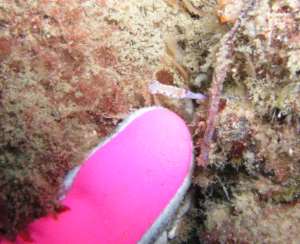
Dear Chris,
You did well to find it! The name brevicaudatum means 'short tail' which refers to the very stumpy dorsal horn at the posterior end of the mantle. If you compare it with animals such as C. trilobatum you can see how appropriate it is. As I discuss on the species' Fact Sheet the tip of the 'tail' is where much of the animal's defensive chemicals are stored in large mantle glands. This stumpy tail is often brightly coloured, particularly so in juveniles, and I have suggested that this brightly coloured patch acts as a lure, attracting fish to bite the most distasteful, and replaceable, bit of the body.
Best wishes,
Bill Rudman
Re: Ceratosoma brevicaudatum from Botany Bay
May 31, 2005
From: Nicholas Missenden
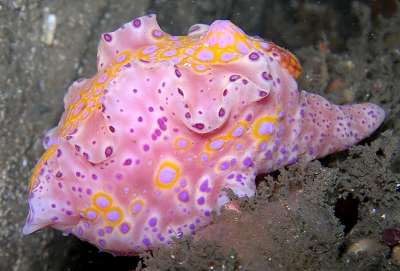
Hello Bill,
Thankyou for identifying this nudi for me [message #13864 ]. After reading some associated posts I thought I would send you a another picture that I have take with everything retracted, gills, rhinophores.
Regards
Nick
njmpm@iinet.net.au
Missenden, J.N., 2005 (May 31) Re: Ceratosoma brevicaudatum from Botany Bay. [Message in] Sea Slug Forum. Australian Museum, Sydney. Available from http://www.seaslugforum.net/find/13897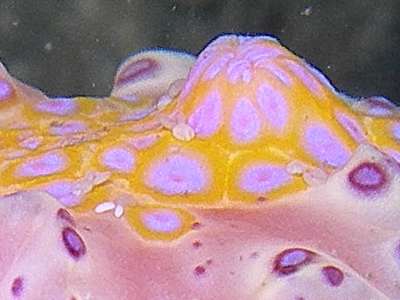
Dear Nick,
Your photo also contains something else of interest. When I decided to cut out part of your photo (alongside) to show the closed up gill pocket I noticed that the Ceratosoma was home to an infestation of little crustaceans called copepods [see symbiosis Fact Sheet]. The easiest one to see is the one in the front left side of the photo. It has two white tail-like structures which are in fact its egg sacs. I think I can make out about 5 copepods in this close-up. The photo also shows the volcano-like structure, which is the tightly closed gill pocket.
Best wishes,
Bill Rudman
Ceratosoma brevicaudatum from Botany Bay
May 27, 2005
From: Nicholas Missenden
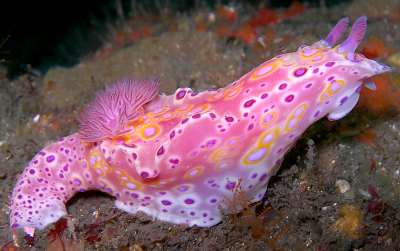
Hello again,
I thought I would send in this photo that I took of what I believe to be a nicely coloured Ceratosoma sinuata, correct me if im wrong please. Photo taken May 2005 at Bare Island, South Wall, depth approx 18m.
Locality: Bare Island, South Wall, Botany Bay, Sydney, NSW, Australia. Depth: 18 m. Length: approx 10 cm. May 2005. Incoming tide, hotographer: Nicholas Missenden.
Regards
Nick
njmpm@iinet.net.au
Nicholas, J.M., 2005 (May 27) Ceratosoma brevicaudatum from Botany Bay. [Message in] Sea Slug Forum. Australian Museum, Sydney. Available from http://www.seaslugforum.net/find/13864Dear Nick,
This is Ceratosoma brevicaudatum, a species found only in southern Australia. By chance I have recently posted a message [#13871] from South Africa about their temperate water species of Ceratosoma ingozi, which is quite similar in shape and colour range.
Best wishes,
Bill Rudman
Ceratosoma brevicaudatum feeding
March 8, 2004
From: John Chuk
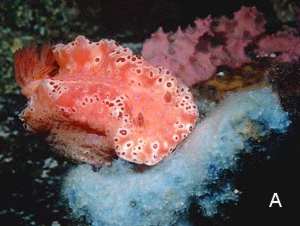
Dear Bill,
I am able to add to the evidence provided by Leanne and David Atkinson [#12084] and Nerida Wilson [#12194] that Ceratosoma brevicaudatum feeds on a blue sponge. Here are images of C. brevicaudatum specimens feeding on blue sponges at three different sites in South Australia. I have records of the species feeding on a similar sponge in Victoria.
A. Edithburgh Jetty, 6 April 1998. Depth 4.5m.
B. Port Hughes Jetty, 8 April 1998. Depth 6m.
C. Point Turton Jetty, 2 March 2001. Depth 3m.
Best wishes,
John.
jchuk@giant.net.au
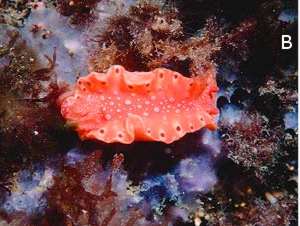
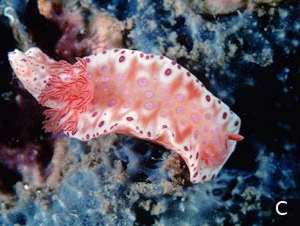
Thanks John,
Bill Rudman
Ceratosoma brevicaudatum laying eggs
February 17, 2004
From: Leanne & David Atkinson
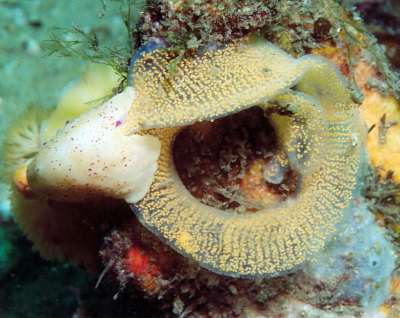
Dear Bill,
We found Ceratosoma brevicaudatum laying eggs. Although they are a very common nudibranch in this area this is the first time we've seen this.
Date: 07 February 2004
Location: Fly Point, Marine Reserve, Port Stephens, NSW, Australia
Time: 10:30am Tide: High 1.77m
Depth: 10m Water Temp: 18 degrees celcius
Hope this is of interest,
Leanne & David Atkinson
atk@hunterlink.net.au
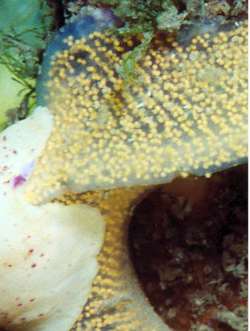
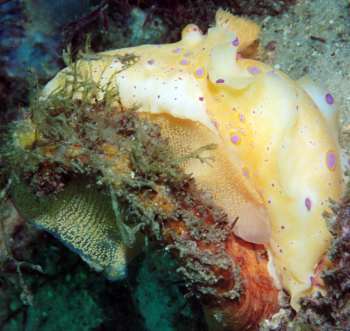
Dear Leanne & David,
Thanks for this interesting observation. I have seen it laying but have not got a good photo, so this is very useful. It looks like it is laying the egg ribbon alongside a patch of the sponge you have found it eating - see the blue patch in the bottom right of the upper photo.
Best wishes
Bill Rudman
Ceratosoma brevicaudatum feeding
February 17, 2004
From: Nerida Wilson
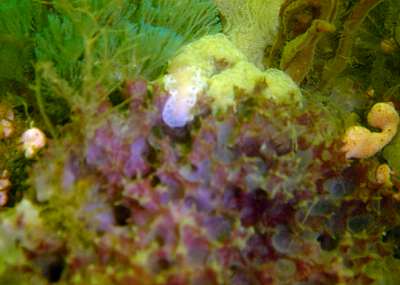
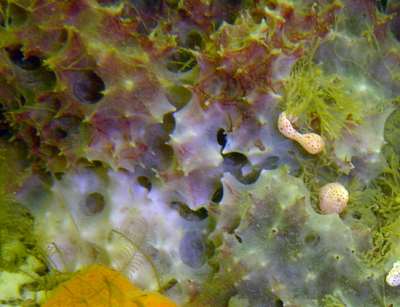
Hi Bill,
I have some photos that support David and Leannes observation [#12084] on Ceratosoma brevicaudatum feeding. I found a juvenile also feeding on a similar mauve sponge in Westernport Bay, Victoria, Australia. The photo that includes the (fuzzy!) nudibranch shows most of the sponge, and how it is overgrown with a filamentous red material. I also took a closer pic to show an area of the sponge without overgrowth. These pictures were taken at 4m in December 2003 at Crawfish Rock. This site is heavily silted, and has a kind of photo-upwelling (where deeper water animals are often found quite shallowly). It is prone to strong currents.
Cheers
Nerida
nwilson@marine.uq.edu.au
Wilson, N., 2004 (Feb 17) Ceratosoma brevicaudatum feeding. [Message in] Sea Slug Forum. Australian Museum, Sydney. Available from http://www.seaslugforum.net/find/12194Thanks Nerida,
These should help identification of the sponge. It definitely feeds on a sponge which is not very good at keeping organisms from growing all over it, and your sponge certainly meets that criteria
Best wishes
Bill Rudman
Ceratosoma brevicaudatum feeding
February 11, 2004
From: Leanne & David Atkinson
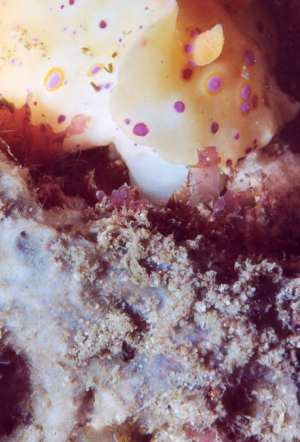
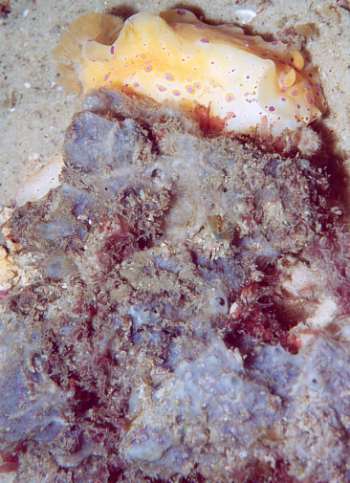
Dear Bill,
We found this Ceratosoma brevicaudatum feeding last weekend and could see enough of the sponge that you may be able to identify it more easily than in our previous message. This sponge is scattered over a sandy bottom. It forms various shapes from the traditional rounded blob to a growth pattern that is flatter, spreading horizontally, taking the shape of the sandy terrain it is growing over. It appears a blue to mauve colour and often has other growth on it. The shots attached are all of the one individual who was wrapped around the sponge at the base where the sponge takes on the sand as part of its structure as in the previous message. We were wondering whether this combination of sand and sponge is necessary or whether on these two occasions it was just convenient.
Date: 25 January 2004
Location: Fly Point Marine Reserve, Port Stephens, NSW, Australia
Depth: 8m Tide: high 1.7m Time: 12:00pm
Water Temp:19 degrees celcius
Cheers,
Leanne & David Atkinson
atk@hunterlink.net.au
Atkinson, L. & D., 2004 (Feb 11) Ceratosoma brevicaudatum feeding. [Message in] Sea Slug Forum. Australian Museum, Sydney. Available from http://www.seaslugforum.net/find/12084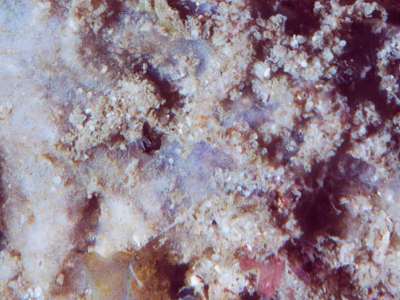
Dear Leanne & David,
Thanks for the photos. They are a great help
Best wishes
Bill Rudman
Ceratosoma brevicaudatum feeding
January 21, 2004
From: Leanne & David Atkinson
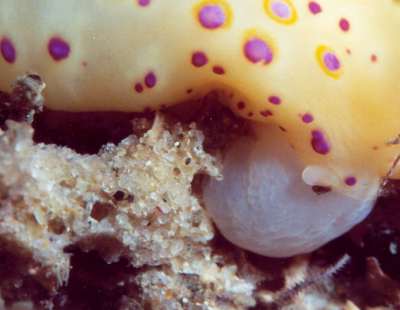
Dear Bill,
We found this Ceratosoma brevicaudatum with it's mouth everted, presumably feeding. The sponge / food is difficult to see.
Halifax Sponge Gardens, Marine Reserve, Port Stephens, NSW, Australia. 02 January 2004. Depth: 16m Tide: High 1.16m Time: 6:00pm. Water Temperature: 16 degrees C.
Hope this is of use.
Yours sincerely,
Leanne & David Atkinson
atk@hunterlink.net.au
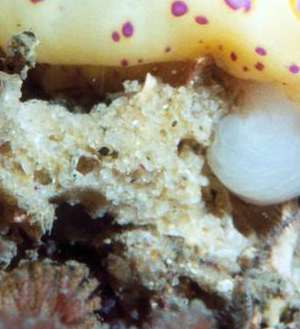
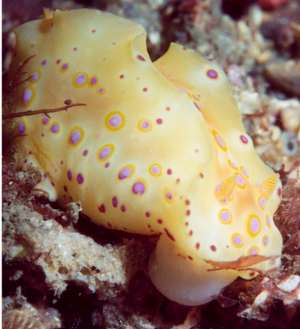
Dear Leanne & David,
Photos of nudibranchs 'doing things' are always valuable. It seems that it is eating a sponge which incorporates sand grains into it skeleton, which makes it very difficult to identify as a sponge. I'll let you know when I get it identified.
Best wishes
Bill Rudman
Ceratosoma brevicaudatum feeding
November 18, 2003
From: Sue Newson
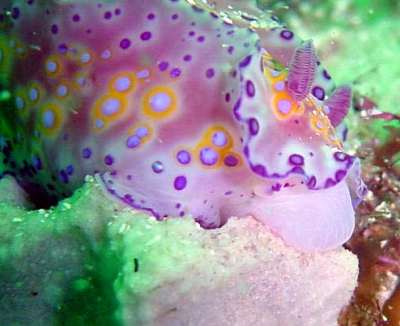
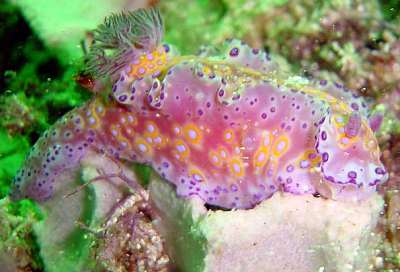
How excited I got during a dive at The Docks - Jervis Bay [New South Wales, Australia] on 9 November 2003 at 1100am.
I previously sent you a message regarding this nudibranch, when I first sighted it. This time again, the visibility was bad (5m green).
I found it within 10m from the area of that initial sighting, although it was on an isolated bombie with 8m of sand between.
This time I found it feeding.
Depth 21m
Length approx 80mm
Regards,
Sue
snewson@shoal.net.au
Newson, S., 2003 (Nov 18) Ceratosoma brevicaudatum feeding. [Message in] Sea Slug Forum. Australian Museum, Sydney. Available from http://www.seaslugforum.net/find/11410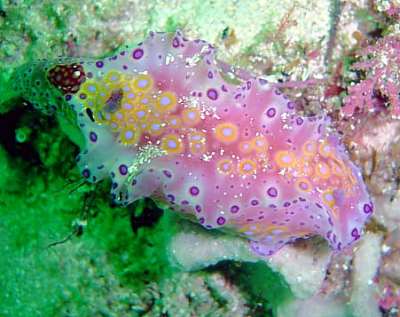
Thanks Sue,
A good find. It is a rare record of this species feeding.
Best wishes
Bill Rudman
Ceratosoma brevicaudatum from eastern Australa
May 14, 2003
From: Sue Newson
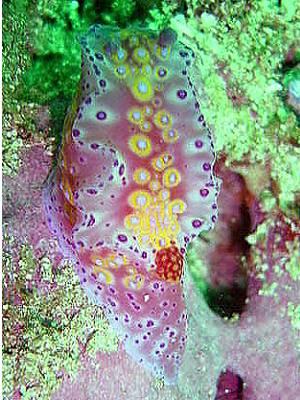
I found this Ceratosoma brevicaudatum at the Docks in Jervis Bay [eastern Australia] on 4 February 2003 at 2.20pm, although the viz was so bad, a lot of nocturnal animals were out feeding. I found it at a depth of 20m, water temp 20*C. It was the only one, about 6cm, and moving.
Never seen this species in Jervis Bay before or since.
Sue Newson
snewson@shoal.net.au
Newson, S., 2003 (May 14) Ceratosoma brevicaudatum from eastern Australa. [Message in] Sea Slug Forum. Australian Museum, Sydney. Available from http://www.seaslugforum.net/find/9838Thanks Sue,
This species seems to be more common in southern Australia [Victoria, Tasmania, S. Australia] than it does in eastern Australia.
Best wishes,
Bill Rudman
Ceratosoma brevicaudatum from Port Stephens, NSW
December 11, 2002
From: Ian Simpson
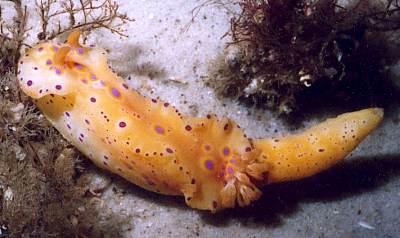
Dear Bill,
Here is Ceratosoma brevicaudatum from Nelson Bay (Fly Point, NSW, Australia) 19th August 2001. 7 metres
Ian Simpson
barts computer@hotmail.com
Thanks Ian,
Bill Rudman
Ceratosoma brevicaudatum from South Australia
February 22, 2002
From: Stuart Hutchison
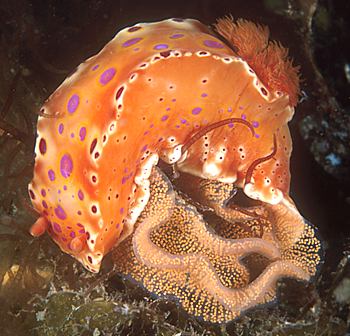
Bill,
here's Ceratosoma brevicaudatum from Rapid Bay, South Australia in Nov 2001. Depth 9m, length 70mm with eggmass.
Stuart
stuart@stuarthutchison.com.au
Hutchison, S., 2002 (Feb 22) Ceratosoma brevicaudatum from South Australia. [Message in] Sea Slug Forum. Australian Museum, Sydney. Available from http://www.seaslugforum.net/find/6284Thanks Stuart,
It's good to get a photo of the egg ribbon. I have some sketches and scribbled notes but no photo.
Best wishes,
Bill Rudman
Ceratosoma amoena and ? from Nelson Bay, NSW
April 25, 2001
From: David Harasti
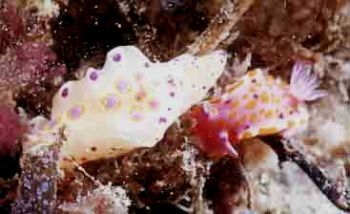
Hi Bill,
These 2 pics were taken at Halifax Park at Nelson Bay, New South Wales, Australia in April 2001. Depth was about 15 metres and water temp was 23 degrees. Obviously 1 animal is Ceratosoma amoena but I am not sure what the other species is. Is it a colour variation of Ceratosoma amoena?
Thanks,
David
http://www2.dynamite.com.au/davidh/index.htm
davidh@dynamite.com.au
Harasti, D., 2001 (Apr 25) Ceratosoma amoena and ? from Nelson Bay, NSW. [Message in] Sea Slug Forum. Australian Museum, Sydney. Available from http://www.seaslugforum.net/find/4229Dear Dave,
The one on the right in the upper photo is C. amoena, and the other one is another species of Ceratosoma, Ceratosoma brevicaudatum. Both these species are found around southern Australia and are a pair of temperate representatives of what is otherwise a tropical genus. In the bottom photo you can see a bright orange-red knob at the rear of the mantle (left side of photo). This is the very short 'tail' which gives this species its name: brevi = short; caudatum = tail.
If you look at the top of the page you will see a photo of two juveniles with very prominent 'short tails'. This is where species of Certaosoma store distasteful chemicals which they use to deter predators. I think the brightly coloured patch is a 'lure' to attract potential predators to this most distasteful part of their body. If the predator bights off a bit of this tissue, it does not really hurt the nudibranch and ensures the predator gets a very nasty mouthful.
The other species on your photo, Ceratosoma amoena, is a primitive member of the genus and has no tail. Look at Ceratosoma trilobatum and Ceratosoma tenue for two tropical species in which the 'tail' has developed into a large dorsal horn.
Best wishes,
Bill Rudman
Re: Feeding in Ceratosoma brevicaudatum
October 27, 2000
From: Des Paroz
Hi Bill
Your response has got me wondering.
Firstly, I am 100% about the critter being a dorid nudibranch. Absolutely certain of that. And I did take quite some time to study the aspects (having followed the forum in detail, I'm learning what to look for in features and behaviour). Based on that, and comparing that with photos in Debelius and WA books, and your site, I am 95%+ sure of the identification of it as C. brevicaudatum.
Not sure if you know Bushrangers Bay at all, but the nudi was found in the shallows of the inner bay. This part of the bay is predominantly sand bottom, with large clumps of sea grass. There are some rocky areas, with small amounts of sponge growth.
Inner Bushrangers Bay is not a great spot for sub-tidal nudis.
This particular individual was found in a small clump of green sea grass on sand, with no visible sponge growth in the immediate vicinity. Maybe at least 10m away. I will certainly check this spot next time I dive the bay and look for any sponge growth. I know the bay reasonably well (at least 150 dives there), and can get back to the same spot easily. Being a large nudi I was able to pay close attention. It was curling around arms of sea grass, and really appeared to be feeding.
A mystery - I wish I'd had the camera.....
Best regards
Des
des@paroz.com
Paroz, D., 2000 (Oct 27) Re: Feeding in Ceratosoma brevicaudatum. [Message in] Sea Slug Forum. Australian Museum, Sydney. Available from http://www.seaslugforum.net/find/3216Dear Des,
It's pretty hard to mistake Ceratosoma brevicaudatum for anything else so I guess the puzzle is to find what it is doing. Not all sponge-feeding nudibranchs stay on their food sponges and often sponges may form a thin layer over rocks and other hard surfaces and then become partly overgrown themselves making it extremely difficult to see them.
These dorids can live for some time without feeding so it could be travelling, and looking for a new sponge colony, or its food could be close by but very cryptic. A good example is the common intertidal dorid Rostanga arbutus in New South Wales, Australia. Any visitor to rock platforms is likely to see this bright orange-red nudibranch crawling busily along in rockpools. And yet it took me about 10 years to find what sponge it ate. One time with a hammer and chisel I broke off a slab of sandstone to expose a thin layer of the sponge Clathria aceratoobtusa which had been living in the crack, a millimeter or so wide, in the sandstone. Rostanga, apparently living in an environment devoid of any potential sponge food was in fact living in a place where its food was abundant, but just not visible.
Not that I suggest that you attack Bushrangers Bay with a jackhammer in search of sponges, its just that sometimes an answer, which seems so simple with hindsight, is very difficult to find.
Best wishes,
Bill Rudman.
Feeding in Ceratosoma brevicaudatum
October 20, 2000
From: Des Paroz
Hi Bill
Yesterday (15 October), my girlfriend and I were diving at Bushrangers Bay, Bass Point, and I saw what I initially mistook as a sponge, but on closer inspection realised it to be a large (approx 12cm) nudibranch. Depth was about 1.5m only.
Checking a couple of reference books later, I identified this to have been a C. brevicaudatum, a species I've not seen before. It was quite distinct though - cerise coloured body with blue spots down the centre of the body (with yellow rings around the spots), and darker, purple spots along the edge of the body. The gills and rhinopores were of a slightly lighter colouration than the rest of the body, with whitish "specs".
Looking at your page on C. brevicaudatum this morning, I noticed discussion about what this nudi feasts on. The one we saw was most definitely munching away on green sea grass, which was growing on the shallow, sandy bottom.
A wader had just swum past when we noticed it, and its gills were initially retracted, but opened up within a minute or so. Didn't have the camera with me, isn't it always the way?
Best regards
Des
des@paroz.com
Paroz, D., 2000 (Oct 20) Feeding in Ceratosoma brevicaudatum. [Message in] Sea Slug Forum. Australian Museum, Sydney. Available from http://www.seaslugforum.net/find/3186Dear Des,
A very puzzling observation. From your description of retractile gills and rhinophores I would assume you had a dorid nudibranch, and nudibranchs are not herbivorous. I know my carnivorous dog eats grass at times when it's sick, but to my knowledge nudibranchs don't. It's possible that there was a sponge colony attached to the sea grasses but apart from that suggestion I really don't know what it was doing.
Best wishes,
Bill Rudman.
Colour variation in Ceratosoma brevicaudatum
September 14, 2000
From: Stuart Hutchison
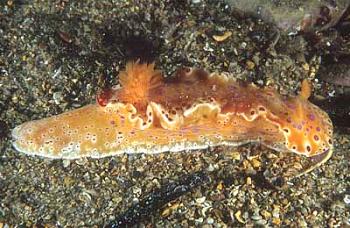
Dear Bill,
Here are some Ceratosoma brevicaudatum from around South Australia. They're common here and vary in colour from quite red to very light, as per your other pictures. They seem to reach lengths of about four inches usually, but I have seen one or two up to about six inches long. Depth's range from shallows at 2m to as deep as it gets here (around 30m) on wrecks/sandy bottom. Common but often beautiful.
Stuart Hutchison.
hutchco@tpg.com.au
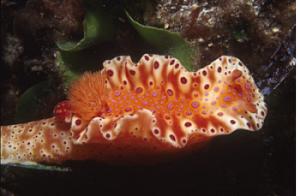
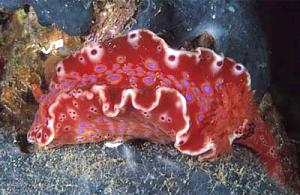
Dear Bruce,
Thanks for the photos. The one at bottom right on the blue sponge may be an interesting food record. C. brevicaudatum does seem to most common in South Australia, although it can be found from New South Wales around to southwestern Australia.
Best wishes,
Bill Rudman.
Ceratosoma brevicaudatum from Sydney
June 9, 2000
From: A. Lumnitzer & D. Piotrowska
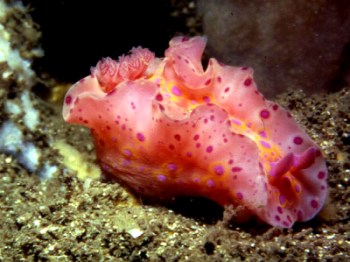
Hi again,
Here is another, perhaps prettier C. brevicaudatum, this time from Shiprock, Port Hacking, Sydney, New South Wales. The shot is from May 1998, in 16m of water and the beast is about 8cm long. That was the only time we have seen this species at Shiprock.
Regards
Akos & Donata
dna72@softhome.net
Lumnitzer, A. & Piotrowska, D., 2000 (Jun 9) Ceratosoma brevicaudatum from Sydney. [Message in] Sea Slug Forum. Australian Museum, Sydney. Available from http://www.seaslugforum.net/find/2524Ceratosoma brevicaudatum from Sydney
June 2, 2000
From: Akos Lumnitzer
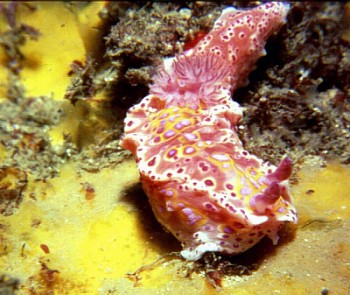
Dear Bill,
Here is Ceratosoma brevicaudatum from Oak Park, Cronulla. May, 1998, 12 meters of water.
I used a 1:3 macro lens, so it would have been around 10cm in length.
Regards
Akos
dna72@softhome.net
Lumnitzer, A., 2000 (Jun 2) Ceratosoma brevicaudatum from Sydney. [Message in] Sea Slug Forum. Australian Museum, Sydney. Available from http://www.seaslugforum.net/find/2488Dear Akos,
We don't have much information on what sponges this species eats so the yellow sponge in the background of your photo is interesting. It would be nice to know if it is often found in association with this sponge, or if you have seen it feeding on this or any other sponge.
Best wishes,
Bill Rudman.
